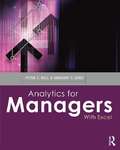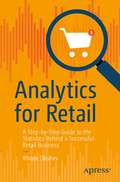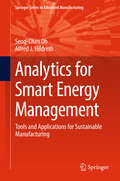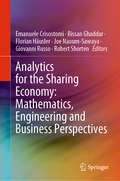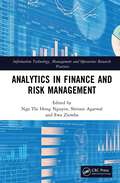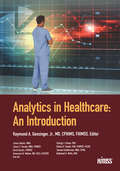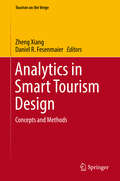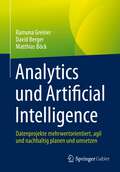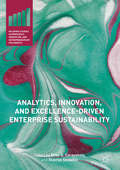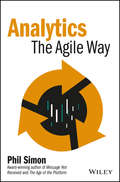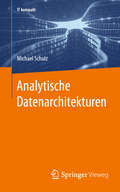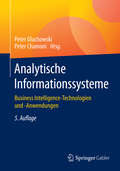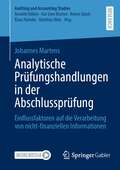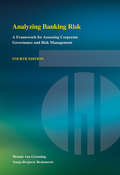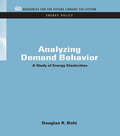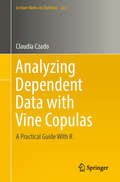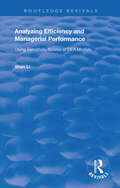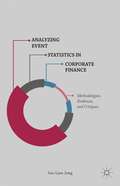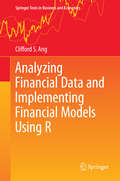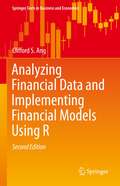- Table View
- List View
Analytics for Managers: With Excel
by Gregory S. Zaric Peter C. BellAnalytics is one of a number of terms which are used to describe a data-driven more scientific approach to management. Ability in analytics is an essential management skill: knowledge of data and analytics helps the manager to analyze decision situations, prevent problem situations from arising, identify new opportunities, and often enables many millions of dollars to be added to the bottom line for the organization. The objective of this book is to introduce analytics from the perspective of the general manager of a corporation. Rather than examine the details or attempt an encyclopaedic review of the field, this text emphasizes the strategic role that analytics is playing in globally competitive corporations today. The chapters of this book are organized in two main parts. The first part introduces a problem area and presents some basic analytical concepts that have been successfully used to address the problem area. The objective of this material is to provide the student, the manager of the future, with a general understanding of the tools and techniques used by the analyst.
Analytics for Retail: A Step-by-Step Guide to the Statistics Behind a Successful Retail Business
by Rhoda OkunevExamine select retail business scenarios to learn basic mathematics, as well as probability and statistics required to analyze big data. This book focuses on useful and imperative applied analytics needed to build a retail business and explains mathematical concepts essential for decision making and communication in retail business environments. Everyone is a buyer or seller of products these days whether through a physical department store, Amazon, or their own business website. This book is a step-by-step guide to understanding and managing the mechanics of markups, markdowns, and basic statistics, math and computers that will help in your retail business. You'll tackle what to do with data once it is has accumulated and see how to arrange the data using descriptive statistics, primarily means, median, and mode, and then how to read the corresponding charts and graphs. Analytics for Retail is your path to creating visual representations that powerfully communicate information and drive decisions. What You'll LearnReview standard statistical concepts to enhance your understanding of retail dataUnderstand the concepts of markups, markdowns and profit margins, and probability Conduct an A/B testing email campaign with all the relevant analytics calculated and explainedWho This Book Is ForThis is a primer book for anyone in the field of retail that needs to learn or refresh their skills or for a reader who wants to move in their company to a more analytical position.
Analytics for Smart Energy Management: Tools and Applications for Sustainable Manufacturing (Springer Series in Advanced Manufacturing)
by Seog-Chan Oh Alfred J. HildrethThis book introduces the issues and problems that arise when implementing smart energy management for sustainable manufacturing in the automotive manufacturing industry and the analytical tools and applications to deal with them. It uses a number of illustrative examples to explain energy management in automotive manufacturing, which involves most types of manufacturing technology and various levels of energy consumption. It demonstrates how analytical tools can help improve energy management processes, including forecasting, consumption, and performance analysis, emerging new technology identification as well as investment decisions for establishing smart energy consumption practices. It also details practical energy management systems, making it a valuable resource for professionals involved in real energy management processes, and allowing readers to implement the procedures and applications presented.
Analytics for the Sharing Economy: Mathematics, Engineering and Business Perspectives
by Giovanni Russo Emanuele Crisostomi Robert Shorten Bissan Ghaddar Florian Häusler Joe Naoum-SawayaThe book provides an encompassing overview of all aspects relating to the sharing economy paradigm in different fields of study, and shows the ongoing research efforts in filling previously identified gaps in understanding in this area. Control and optimization analytics for the sharing economy explores bespoke analytics, tools, and business models that can be used to help design collaborative consumption services (the shared economy). It provides case studies of collaborative consumption in the areas of energy and mobility.The contributors review successful examples of sharing systems, and explore the theory for designing effective and stable shared-economy models. They discuss recent innovations in and uses of shared economy models in niche areas, such as energy and mobility. Readers learn the scientific challenging issues associated with the realization of a sharing economy. Conceptual and practical matters are examined, and the state-of-the-art tools and techniques to address such applications are explained. The contributors also show readers how topical problems in engineering, such as energy consumption in power grids, or bike sharing in transportation networks, can be formulated and solved from a general collaborative consumption perspective. Since the book takes a mathematical perspective to the topic, researchers in business, computer science, optimization and control find it useful. Practitioners also use the book as a point of reference, as it explores and investigates the analytics behind economy sharing.
Analytics in Finance and Risk Management (Information Technology, Management and Operations Research Practices)
by Ewa Ziemba Shivani Agarwal Nga Thi Hong NguyenThis book presents contemporary issues and challenges in finance and risk management in a time of rapid transformation due to technological advancements. It includes research articles based on financial and economic data and intends to cover the emerging role of analytics in financial management, asset management, and risk management. Analytics in Finance and Risk Management covers statistical techniques for data analysis in finance It explores applications in finance and risk management, covering empirical properties of financial systems. It addresses data science involving the study of statistical and computational models and includes basic and advanced concepts. The chapters incorporate the latest methodologies and challenges facing financial and risk management and illustrate related issues and their implications in the real world. The primary users of this book will include researchers, academicians, postgraduate students, professionals in engineering and business analytics, managers, consultants, and advisors in IT firms, financial markets, and services domains.
Analytics in Healthcare: An Introduction (HIMSS Book Series)
by Raymond A. GensingerThe editors of the HIMSS Books' best-seller Health: From Smartphones to Smart Systems have returned to deliver an expansive survey of the initiatives, innovators, and technologies driving the patient-centered mobile healthcare revolution. mHealth Innovation: Best Practices from the Mobile Frontier explores the promise of mHealth as a balance between emerging technologies and process innovations leading to improved outcomes-with the ultimate aim of creating a patient-centered and consumer-driven healthcare ecosystem. Examining the rapidly changing mobile healthcare environment from myriad perspectives, the book includes a comprehensive survey of the current-state ecosystem-app development, interoperability, security, standards, organizational and governmental policy, innovation, next-generation solutions, and mBusiness-and 20 results-driven, world-spanning case studies covering behavior change, patient engagement, patient-provider decision making, mobile gaming, mobile prescription therapy, home monitoring, mobile-to-mobile online delivery, access to care, app certification and quality evaluations, mixed media campaigns, and much more.
Analytics in Smart Tourism Design: Concepts and Methods (Tourism on the Verge)
by Daniel R. Fesenmaier Zheng XiangThis book presents cutting edge research on the development of analytics in travel and tourism. It introduces new conceptual frameworks and measurement tools, as well as applications and case studies for destination marketing and management. It is divided into five parts: Part one on travel demand analytics focuses on conceptualizing and implementing travel demand modeling using big data. It illustrates new ways to identify, generate and utilize large quantities of data in tourism demand forecasting and modeling. Part two focuses on analytics in travel and everyday life, presenting recent developments in wearable computers and physiological measurement devices, and the implications for our understanding of on-the-go travelers and tourism design. Part three embraces tourism geoanalytics, correlating social media and geo-based data with tourism statistics. Part four discusses web-based and social media analytics and presents the latest developments in utilizing user-generated content on the Internet to understand a number of managerial problems. The final part is a collection of case studies using web-based and social media analytics, with examples from the Sochi Olympics on Twitter, leveraging online reviews in the hotel industry, and evaluating destination communications and market intelligence with online hotel reviews. The chapters in this section collectively describe a range of different approaches to understanding market dynamics in tourism and hospitality.
Analytics in a Big Data World
by Bart BaesensThe guide to targeting and leveraging business opportunities using big data & analyticsBy leveraging big data & analytics, businesses create the potential to better understand, manage, and strategically exploiting the complex dynamics of customer behavior. Analytics in a Big Data World reveals how to tap into the powerful tool of data analytics to create a strategic advantage and identify new business opportunities. Designed to be an accessible resource, this essential book does not include exhaustive coverage of all analytical techniques, instead focusing on analytics techniques that really provide added value in business environments.The book draws on author Bart Baesens' expertise on the topics of big data, analytics and its applications in e.g. credit risk, marketing, and fraud to provide a clear roadmap for organizations that want to use data analytics to their advantage, but need a good starting point. Baesens has conducted extensive research on big data, analytics, customer relationship management, web analytics, fraud detection, and credit risk management, and uses this experience to bring clarity to a complex topic.Includes numerous case studies on risk management, fraud detection, customer relationship management, and web analytics Offers the results of research and the author's personal experience in banking, retail, and governmentContains an overview of the visionary ideas and current developments on the strategic use of analytics for businessCovers the topic of data analytics in easy-to-understand terms without an undo emphasis on mathematics and the minutiae of statistical analysisFor organizations looking to enhance their capabilities via data analytics, this resource is the go-to reference for leveraging data to enhance business capabilities.
Analytics the Right Way: A Business Leader's Guide to Putting Data to Productive Use
by Tim Wilson Joe SutherlandCLEAR AND CONCISE TECHNIQUES FOR USING ANALYTICS TO DELIVER BUSINESS IMPACT AT ANY ORGANIZATION Organizations have more data at their fingertips than ever, and their ability to put that data to productive use should be a key source of sustainable competitive advantage. Yet, business leaders looking to tap into a steady and manageable stream of “actionable insights” often, instead, get blasted with a deluge of dashboards, chart-filled slide decks, and opaque machine learning jargon that leaves them asking, “So what?” Analytics the Right Way is a guide for these leaders. It provides a clear and practical approach to putting analytics to productive use with a three-part framework that brings together the realities of the modern business environment with the deep truths underpinning statistics, computer science, machine learning, and artificial intelligence. The result: a pragmatic and actionable guide for delivering clarity, order, and business impact to an organization’s use of data and analytics. The book uses a combination of real-world examples from the authors’ direct experiences—working inside organizations, as external consultants, and as educators—mixed with vivid hypotheticals and illustrations—little green aliens, petty criminals with an affinity for ice cream, skydiving without parachutes, and more—to empower the reader to put foundational analytical and statistical concepts to effective use in a business context.
Analytics und Artificial Intelligence: Datenprojekte mehrwertorientiert, agil und nachhaltig planen und umsetzen
by Matthias Böck David Berger Ramona GreinerDie Autoren zeigen in diesem Buch, wie man für eigene Data-Science-Projekte mit Data Analytics und AI einen echten (Mehr-)Wert schafft. Sie entwickeln einen Leitfaden, mit dem Sie Ihre Datenanalyse systematisch, agil und nutzer:innenzentriert aufbauen und betreiben können. Zunächst machen die Autoren klar, wie wichtig es ist zu Beginn Ihrer Analytics-Projekte die für Ihr Geschäftsmodell richtigen und wertstiftenden Fragen zu stellen. Im Anschluss erläutern sie, wie Sie Technologien und Daten so einsetzen, dass sie einen echten Mehrwert erzeugen können. Schließlich zeigen sie, wie Sie die Projekte effektiv, effizient und gewinnbringend umsetzen können. Das Fundament dafür bilden agile Methoden und Design Thinking, die die Autoren für alltägliche Analytics- und Data-Science-Projekte überführt und adaptiert haben.Mit zahlreichen Beispielen und Erfahrungen aus Daten-, Web- und Digital-Analytics-Projekten sowie zwei realen Beispielen, wie man von der Idee und dem Auftrag zum Prototypen kommt. Aus dem Inhalt Agile Basics: Agile Prinzipien und ErfolgsfaktorenVom Design Thinking zum Data Thinking – wie Design Thinking Datenprojekte besser machtArtificial Intelligence – wie Künstliche Intelligenz mehrwertorientiert in Data Analytics eingesetzt werden kannEthische, rechtliche und ökologische Implikationen – wie Data Analytics und AI doch kein Schreckgespenst werdenDer Data Value Loop - Datenmehrwert agil und nutzer:innenzentriertAnalytics in der Praxis – von der Konzeption über Tracking und Reporting bis zum Arbeitsmeeting im AlltagAI in der Praxis - Data Science und Agile, geht das überhaupt zusammen? Zwei exemplarische ProjektdurchführungenGlossar
Analytics, Innovation, and Excellence-Driven Enterprise Sustainability (Palgrave Studies in Democracy, Innovation, and Entrepreneurship for Growth)
by Elias G. Carayannis Stavros SindakisThis book offers a unique view of how innovation and competitiveness improve when organizations establish alliances with partners who have strong capabilities and broad social capital, allowing them to create value and growth as well as technological knowledge and legitimacy through new knowledge resources. Organizational intelligence integrates the technology variable into production and business systems, establishing a basis to advance decision-making processes. When strategically integrated, these factors have the power to promote enterprise resilience, robustness, and sustainability. This book provides a unique perspective on how knowledge, information, and data analytics create opportunities and challenges for sustainable enterprise excellence. It also shows how the value of digital technology at both personal and industrial levels leads to new opportunities for creating experiences, processes, and organizational forms that fundamentally reshape organizations.
Analytics: The Agile Way
by Phil SimonFor years, organizations have struggled to make sense out of their data. IT projects designed to provide employees with dashboards, KPIs, and business-intelligence tools often take a year or more to reach the finish line...if they get there at all. This has always been a problem. Today, though, it's downright unacceptable. The world changes faster than ever. Speed has never been more important. By adhering to antiquated methods, firms lose the ability to see nascent trends—and act upon them until it's too late. But what if the process of turning raw data into meaningful insights didn't have to be so painful, time-consuming, and frustrating? What if there were a better way to do analytics? Fortunately, you're in luck... Analytics: The Agile Way is the eighth book from award-winning author and Arizona State University professor Phil Simon. Analytics: The Agile Way demonstrates how progressive organizations such as Google, Nextdoor, and others approach analytics in a fundamentally different way. They are applying the same Agile techniques that software developers have employed for years. They have replaced large batches in favor of smaller ones...and their results will astonish you. Through a series of case studies and examples, Analytics: The Agile Way demonstrates the benefits of this new analytics mind-set: superior access to information, quicker insights, and the ability to spot trends far ahead of your competitors.
Analytische Datenarchitekturen (IT kompakt)
by Michael SchulzLange Zeit waren Data Warehouse, Data Mart und Operational Data Store die einzigen verbreiteten Komponenten einer analytischen Datenarchitektur. Die zunehmende Verwendung komplexer Daten zur Entscheidungsunterstützung hat in den letzten Jahren Architekturkomponenten wie den Data Lake oder Möglichkeiten zur analytischen Verwendung von Stromdaten hervorgebracht. War ihr Einsatz in vielen Organisationen zunächst von Misserfolgen begleitet, haben sich mittlerweile Grundsätze etabliert, die einen sinnvollen Einsatz ermöglichen. Seit kurzem sind mit Data Lakehouse, Data Fabric und Data Mesh weitere Ansätze in der Diskussion. Durch diese Vielzahl existierender Ansätze ist der Themenkomplex unübersichtlich geworden und es wird immer schwieriger, den Überblick zu behalten. Genau darin liegt die Zielsetzung des vorliegenden Buches: Mit einem klaren Fokus auf derzeit relevante Architekturkomponenten sollen ihre Hauptmerkmale verdeutlicht werden.
Analytische Informationssysteme: Business Intelligence-Technologien und -Anwendungen
by Peter Gluchowski Peter ChamoniInformationssysteme für die analytischen Aufgaben von Fach- und Führungskräften treten verstärkt in den Vordergrund. Dieses etablierte Buch diskutiert und evaluiert Begriffe und Konzepte wie Business Intelligence und Big Data. Die aktualisierte und erweiterte fünfte Auflage liefert einen aktuellen Überblick zu Technologien, Produkten und Trends im Bereich analytischer Informationssysteme. Beiträge aus Wirtschaft und Wissenschaft geben einen umfassenden Überblick und eignen sich als fundierte Entscheidungsgrundlage beim Aufbau und Einsatz derartiger Technologien.
Analytische Prüfungshandlungen in der Abschlussprüfung: Einflussfaktoren auf die Verarbeitung von nicht-finanziellen Informationen (Auditing and Accounting Studies)
by Johannes MartensIn der Abschlussprüfung werden neben Informationen aus der traditionellen Analyse von finanziellen Daten zunehmend Informationen aus der Analyse von nicht-finanziellen Daten berücksichtigt. Die Nutzung von nicht-finanziellen Informationen ist hierbei kein neues Phänomen, jedoch ermöglichen jüngere datenanalytische Verfahren, wie z. B. Text-Data-Mining, die Auswertung bisher wenig beachteter, unkonventioneller Datenquellen, die zunehmend in die prüferische Urteilsfindung Eingang finden. In diesem Zusammenhang wird in dieser Arbeit aus einer verhaltenswissenschaftlichen Perspektive untersucht, welche Bedeutung nicht-finanzielle Informationen aus der Analyse von Wetter-, Strom- und Internetdaten zur Plausibilisierung der Umsatzerlöse im Rahmen einer analytischen Prüfungshandlung für Prüfer besitzen. Hierfür wird eine experimentelle Untersuchung mit Prüfern durchgeführt, die drei wesentliche Faktoren bei der Verarbeitung der nicht-finanziellen Informationen fokussiert: das Bedürfnis nach kognitiver Geschlossenheit, die Informationskonsistenz und der fraud-Risiko-Kontext. Die Ergebnisse deuten unter anderem auf einen Einfluss des Bedürfnisses nach kognitiver Geschlossenheit und der Informationskonsistenz hin. Die Befunde liefern interessante Einsichten für Prüfungspraxis und -forschung.
Analyzing Banking Risk (Fourth Edition): A Framework for Assessing Corporate Governance and Risk Management
by Hennie van Greuning Sonja Brajovic BratanovicAnalyzing Banking Risk: A Framework for Assessing Corporate Governance and Risk Management provides a comprehensive overview of topics focusing on assessment, analysis, and management of financial risks in banking. The publication emphasizes risk management principles and stresses that key players in the corporate governance process are accountable for managing the different dimensions of financial and other risks. This fourth edition remains faithful to the objectives of the original publication. It covers new business aspects affecting banking risks, such as mobile banking and regulatory changes over the past decade—specifically those related to Basel III capital adequacy concepts—as well as new operational risk management topics such as cybercrime, money laundering, and outsourcing. This publication will be of interest to a wide body of users of bank financial data. The target audience includes the persons responsible for the analysis of banks and for the senior management or organizations directing their efforts. Because the publication provides an overview of the spectrum of corporate governance and risk management, it is not aimed at technical specialists of any particular risk management area. *** Hennie van Greuning was formerly a Senior Adviser in the World Bank’s Treasury Unit and previously worked as a sector manager for financial sector operations in the World Bank. He has been a partner in a major international accounting firm and a controller and head of bank supervision in a central bank. Since retiring from the World Bank, he has chaired audit, ethics, and risk committees in various banks and has been a member of operational risk and asset-liability management committees. Sonja Brajovic Bratanovic was a Lead Financial Sector Specialist at the World Bank, after a career as a senior official in a central bank. With extensive experience in banking sector reforms and financial risk analysis, she led World Bank programs for financial sector reforms, as well as development projects. Since her retirement, she has continued as a senior consultant for World Bank development projects in the financial sector, as well as an advisor for other development institutions.
Analyzing Banking Risk: A Framework for Assessing Corporate Governance and Risk Management
by Sonja Brajovic-Bratanovic Hennie Van GreuningThis book provides a comprehensive overview of topics focusing on assessment, analysis, and management of financial risks in banking. The publication emphasizes risk-management principles and stresses that key players in the corporate governance process are accountable for managing the different dimensions of financial risk. This third edition remains faithful to the objectives of the original publication. A significant new edition is the inclusion of chapters on the management of the treasury function. Advances made by the Basel Committee on Banking Supervision are reflected in the chapters on capital adequacy, transparency, and banking supervision. This publication should be of interest to a wide body of users of bank financial data. The target audience includes persons responsible for the analysis of banks and for the senior management or organizations directing their efforts.
Analyzing Consumer Perceptions
by Robert J. DolanDescribes the perceptual mapping techniques in a non-technical fashion. The procedure is useful for the depiction of the structure of the market. Discusses alternative methods, presents examples of each, and shows how the maps can be used in marketing decision making.
Analyzing Consumer Preferences
by Robert J. DolanPresents a non-traditional description of the conjoint analysis methodology. Discusses the process by which a study is done and cites areas of application.
Analyzing Demand Behavior: A Study of Energy Elasticities (RFF Energy Policy Set)
by Douglas R. BohiFirst Published in 2011. Routledge is an imprint of Taylor & Francis, an informa company.
Analyzing Dependent Data with Vine Copulas: A Practical Guide With R (Lecture Notes in Statistics #222)
by Claudia CzadoThis textbook provides a step-by-step introduction to the class of vine copulas, their statistical inference and applications. It focuses on statistical estimation and selection methods for vine copulas in data applications. These flexible copula models can successfully accommodate any form of tail dependence and are vital to many applications in finance, insurance, hydrology, marketing, engineering, chemistry, aviation, climatology and health.The book explains the pair-copula construction principles underlying these statistical models and discusses how to perform model selection and inference. It also derives simulation algorithms and presents real-world examples to illustrate the methodological concepts. The book includes numerous exercises that facilitate and deepen readers’ understanding, and demonstrates how the R package VineCopula can be used to explore and build statistical dependence models from scratch. In closing, the book provides insights into recent developments and open research questions in vine copula based modeling.The book is intended for students as well as statisticians, data analysts and any other quantitatively oriented researchers who are new to the field of vine copulas. Accordingly, it provides the necessary background in multivariate statistics and copula theory for exploratory data tools, so that readers only need a basic grasp of statistics and probability.
Analyzing Efficiency & Managerial Performance: Using Sensitivity Scores of DEA Models
by Shan LiThis study was initially the author’s Ph.D dissertation written at the University of Texas at Austin in 1995 entitled “A New Approach to Sensitivity Analysis of the DEA Models and their Applications to Ranking and Productivity Growth.” An updated preface and a general index were added for this book which was originally published in 1996. The primary objective of this study is to demonstrate a new method available to management scientists for evaluating the organizational efficiency performance and analyzing how stable the evaluations are to the sample data collections.
Analyzing Event Statistics In Corporate Finance
by Jau-Lian JengAnalyzing Event Statistics in Corporate Finance provides new alternative methodologies to increase accuracy when performing statistical tests for event studies within corporate finance. In contrast to conventional surveys or literature reviews, Jeng focuses on various methodological defects or deficiencies that lead to inaccurate empirical results, which ultimately produce bad corporate policies. This work discusses the issues of data collection and structure, the recursive smoothing for systematic components in excess returns, the choices of event windows, different time horizons for the events, and the consequences of applications of different methodologies. In providing improvement for event studies in corporate finance, and based on the fact that changes in parameters for financial time series are common knowledge, a new alternative methodology is developed to extend the conventionalanalysis to more robust arguments.
Analyzing Financial Data and Implementing Financial Models Using R (Springer Texts in Business and Economics)
by Clifford S. AngThis book is a comprehensive introduction to financial modeling that teaches advanced undergraduate and graduate students in finance and economics how to use R to analyze financial data and implement financial models. This text will show students how to obtain publicly available data, manipulate such data, implement the models, and generate typical output expected for a particular analysis. This text aims to overcome several common obstacles in teaching financial modeling. First, most texts do not provide students with enough information to allow them to implement models from start to finish. In this book, we walk through each step in relatively more detail and show intermediate R output to help students make sure they are implementing the analyses correctly. Second, most books deal with sanitized or clean data that have been organized to suit a particular analysis. Consequently, many students do not know how to deal with real-world data or know how to apply simple data manipulation techniques to get the real-world data into a usable form. This book will expose students to the notion of data checking and make them aware of problems that exist when using real-world data. Third, most classes or texts use expensive commercial software or toolboxes. In this text, we use R to analyze financial data and implement models. R and the accompanying packages used in the text are freely available; therefore, any code or models we implement do not require any additional expenditure on the part of the student. Demonstrating rigorous techniques applied to real-world data, this text covers a wide spectrum of timely and practical issues in financial modeling, including return and risk measurement, portfolio management, options pricing, and fixed income analysis.
Analyzing Financial Data and Implementing Financial Models Using R (Springer Texts in Business and Economics)
by Clifford S. AngThis advanced undergraduate/graduate textbook teaches students in finance and economics how to use R to analyse financial data and implement financial models. It demonstrates how to take publically available data and manipulate, implement models and generate outputs typical for particular analyses. A wide spectrum of timely and practical issues in financial modelling are covered including return and risk measurement, portfolio management, option pricing and fixed income analysis. This new edition updates and expands upon the existing material providing updated examples and new chapters on equities, simulation and trading strategies, including machine learnings techniques. Select data sets are available online.
